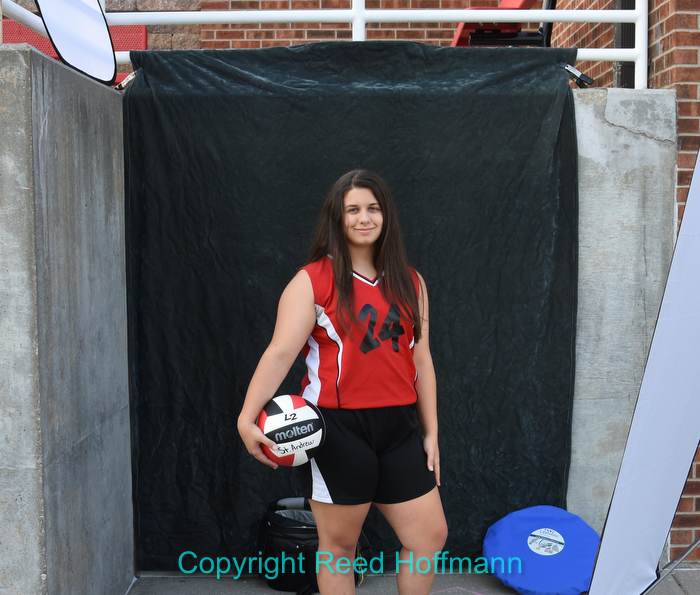A long time ago I learned the hard way that the more I tried to do fancy lighting for portraits, the less likely I’d get a good picture. So my rule became “simple is good.” And that’s just what I did last week.
I’ve got a friend who coaches his kids’ sports, and I sometimes join them to shoot photos. Asking if I could shoot one their upcoming volleyball practices, he wondered if I might be willing to do portraits of the team too. Sure, sounds like fun.
I always preach “subject, light, background,” when teaching photography. That’s just as true with portraits as with any other type. The big difference is you don’t have to look for a subject, that’s already taken care of. So light and background become the keys.
Practice started at 6:30pm, and with nice weather in the forecast, I decided to keep things simple (“simple is good”) and take advantage of available light. Open shade is usually nice for portraits, but lacks the impact of stronger light. A great balance between shade and direct sun can be achieved with reflectors. By reflecting light back onto the subject, you can add a touch of contrast, as well as filling in shadows. Not sure what I’d encounter, I brought a couple of circular reflectors as well as a large self-standing rectangular one. That was one of those great deals I couldn’t pass up a couple of years ago, but hadn’t used yet. Which was about to change.
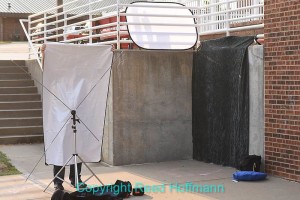
My studio – black backdrop clipped to the wall, large reflector (at left), and diffusion panel at top center to keep shafts of light from striking the backdrop. Photo copyright Reed Hoffmann.
For most portraits, the perfect background is often “clean” – dark, and not distracting. And I probably could have found an area like that there. But to be on the safe side, I also brought along a crushed velvet black backdrop. Just outside the gym I found a small alcove that would let me hang my backdrop, and provide a good space to work in.
With sunshine coming from the left, at first I’d planned to put the girls back in that alcove to keep them in shade. Then I realized I’d be missing out on the warm, soft light from the sunset. So instead, I had them step out into the light, and put the large reflector opposite the sun, to kick that warm light back into their faces. That position let me use the sun as a side-light, which helped separate them from the background. It couldn’t have worked out better.

This is fine, what I would have had just using the soft sunset light coming in from the left side. But it lacks “punch,” and isn’t taking advantage of the nice warm color of the evening light. Nikon D7200, Nikon 24-120mm f/4 lens, ISO 200, 1/400 at f/4, EV -.3, white balance Sunny. Photo copyright Reed Hoffmann.
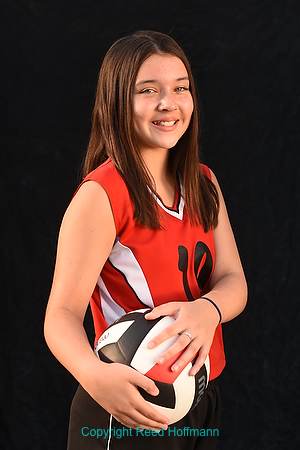
Notice what a difference the reflector makes, now kicking light in from the right side. There’s more warmth to the skin tones, fewer shadows, more “pop” to the photo and nice catchlights in her eyes. Nikon D7200, Nikon 24-120mm f/4 lens, ISO 200, 1/800 at f/4, EV -.3, white balance Sunny. Photo copyright Reed Hoffmann.
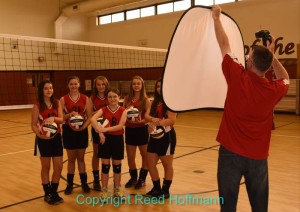
My human light stand in action – Todd holding the diffusion panel in one hand, the Nikon SB-910 flash in the other. By firing the flash through the panel, the light is spread out and made softer, to avoid those hard shadows created by direct flash. Nikon D7200, Nikon 24-120mm f/4 lens, ISO 200, 1/20 at f/6.3, EV -.3, white balance Flash. Photo copyright Reed Hoffmann.
For the group shot, I wanted to have the background reflect what they were – a volleyball team. So we moved inside. The gym was surprisingly well-lit, and also had a bank of windows on the west side letting in some nice, strong light. So again I chose to use that strong natural light as a side-light. For the main light I had my friend hold a diffusion panel (thin white fabric) off to the side and point a Nikon SB-910 flash into it. Setting the camera’s white balance to Flash meant the light on their faces would render with proper skin tones. And setting my exposure manually, for one-stop darker than the available light, both helped the girls stand out better and left some of the warm color in the background from the artificial light. It was easy, and turned out great.
Early in my career, when I first started using multiple strobes, I thought more flashes would mean better pictures. It took me a while to realize it wasn’t the quantity of light that made the picture, but the quality. That’s something I try to remind myself of regularly, both in photography and life – quality’s often more important than quantity.
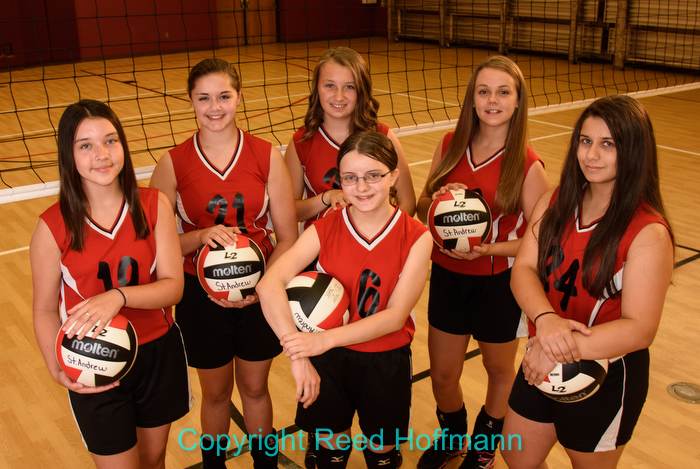
The end result is a combination two lights. The flash, through the diffuser, for good exposure and nice skin tones, and the sunlight coming in from the windows at upper right to add sidelights in their hair. Nikon D7200, Nikon 24-120mm f/4 lens, ISO 200, 1/20 at f/6.3, EV -.3, flash EV -.7, white balance Flash. Photo copyright Reed Hoffmann.

